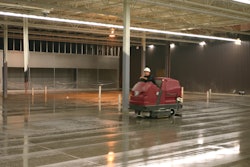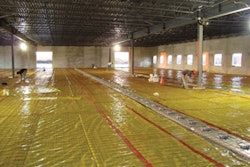This chart showing results of a densifiers abrasion resistance test is a good example of the differences between different types of concrete densifiers/hardeners and the variation in silica types and also concentration ratios.
Product A is a high concentrate sodium silicate
Product B is a high concentrate sodium silicinate
Product C is a low concentrate sodium silicate, silicinate blend
Product D is a low concentrate silica
The concrete was hand troweled and done in the test lab. It was not burned or open but of a typical hand troweled finish.
It is interesting to note that the sodium silicate performed the least well; it has some of the highest concentration of solids. The sodium silicate is trending away from the control.
The sodium silicinate was a step up as far as abrasion resistance to the Taber abrader. It starts off well but quickly falls below the control sample and then returns back toward the control.
The blended sodium silicate/silicinate performed almost as well as the control, and trended back toward the control.
The silica had the best performance and is tracking away from the control in a positive direction.
What do the results mean?
From these results, we could infer that the sodium silicate was not very effective in hardening the concrete. We can also infer that once the abrader wore through the silicinate on the surface of the concrete that the rate of wear was accelerated below the surface but quickly returned to the control. The only product that showed significant positive results were the silica. This was only one test and the variations were not significant enough to draw definitive conclusions.
All of these products were delivered in factory sealed containers and were applied in a similar fashion. Due to variations in application instructions it can be said that they were not applied according to manufactures instructions. Some of the products had higher coverage rates than other and some required multiple coats. It can also be argued that since they were all applied at the same rate per square foot and the same way that the test are equal, and therefore valid. We were trying to determine the effectiveness of one type of silica over another. We were also looking at the concentration of the solutions and suspensions. This was not done as a marketing piece.
There is some debate as to whether an abrader which was designed to measure wear on coatings is appropriate to compare concrete wear. Concrete doesn’t really wear from things being pulled across it. There are instances where things are slid across the surface of concrete that cause wear but not in most cases. It does wear due to penetration. Abrasive material such as sand and grit are being forced into the surface of the slab on the wheels of carts or vehicles.


















